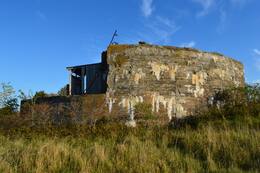Shin beach protection battery no. 43
As early as 1907, Russia began to prepare for the development of pre-defense positions in its capital, St. Petersburg.
The main position was planned on the Tallinn-Porkkala line. The position of the Muhu Strait was planned further in advance to protect the islands and straits. It extended from Hiiumaa to the top of Sõrve. On the other side of the Irben Strait was the Liepaja military port, but it was easily conquered by the Germans. In fact, the calf battery was ready in a state of war and in a hurry. From the very beginning, it was a "saving version". Four east-west single-barreled artillery positions, four of which had been moved backwards from the others, were open and narrow-shot to the Irben Strait. At the same time, partly underground armored towers were built on cannons of the same caliber in Aegna and Naissaar. The war events in Sääre's battery are told in the film "Moonzund" made in the studio Lenfilm in 1987, the prototype of which is the battery no. 43 Commander Senior Lieutenant Nikolai Partenyev. Estonian Jaak Vendla (Feldmann) earned the first position as the commander of the battery. The Zerel 305 mm (12-inch) Coastal Cannon Battery No. 43 consisted of four concrete artillery trays and associated ammunition depots with beam ceilings surrounded by gravel ridges. Each position had its own diesel power plant. The complex also included a control point and an observation tower, its location was almost a kilometer away from Sääre manor. There are also ditches and a large running ditch in the area. They were also used in the battles of 1944, when they were substantially supplemented. In 1941, the bases of the cannon were used as deceptive positions for the so-called Stebel batteries, in which wooden models were built on concrete bases. As a result, the concrete has suffered explosions from aircraft bombs. An extra large funnel is visible in position no .3. The actual construction of the battery began in 1916. This planning began in the autumn of 1912. After the surveying works, construction began, but a port was needed to transport construction materials. Mõntu harbor was completed in 1914. Apparently, the real construction of positions also started at that time. In 1914, a five-kilometer-long railway line with a gauge of 750 mm was built between the port of Mõntu and the battery. In October 1917, two more positions of concrete protective walls were not built. Revolutionary sailors were not prone to order. An explosion in an ongoing ammunition cellar for artillery position 3, which killed 70 sailors and three officers, was wounded and wounded as a result of a fire from an aircraft bomb fired from a German plane. This tragic event further lowered the fighting morale of the battery staff. In October 1917, cannons were blown up by invading the Germans. Thus, the object had only a dissuasive purpose, which closed the entrance of German ships to the Irben Strait, ie to Riga, Kuressaare and Pärnu. In 1922, parts of cannons cut into scrap metal were transported through Mõntu harbor. Since then, the facilities have been idle. It is a rare military complex from the point of view of Saaremaa, Estonia and the world. What makes the Sõrve battery special is that although a similar 12-inch battery is still in Tahkuna, Hiiumaa, it was not possible to build the defensive walls of the positions there. Säär has also retained, to a greater or lesser extent, the locations of the foundations of the auxiliary buildings serving the cannons.
“Mapping of Estonian military historical architectural heritage and analysis of possibilities of use. 19th and 20th Century “Sääre 12-inch beach battery Heritage protection expert assessment Compiler: Tõnu Veldre December 2017
Related objects
Coastal Battery No 43 at Sõrve Säär
This coastal defence battery is situated on the shores of the Gulf of Riga in the village of Sääre on Saaremaa.
Sääre was the site of the 43rd coastal battery of the Moonsund forward position of Peter the Great's Naval Fortress, also known as Zerel. It comprised four 305-mm guns. Construction began in 1914, during World War I, on a limited budget. The artillery pieces were mounted in the open on barbettes, with a narrow firing range over Irbe Strait. These were accompanied by ammunition dumps, diesel generators and a command centre built from logs and surrounded by sand. The wooden fire control tower was around a kilometre away at Sääre Manor. A 5 km long narrow gauge railway was laid connecting the battery with the port in Mõntu.
The concrete artillery barbettes with their rounded bolts, defensive walls of two of the artillery positions and the mound of sand on which the command centre once stood are all that remain today.





